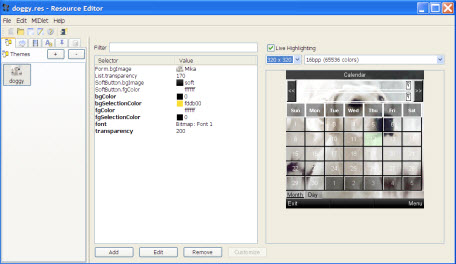This downloaded zip file contains documentation, developer guild, A demo application that uses LWUIT , resource editor. For example, Graphics would be an abstraction of the graphics object in the underlying profile. Internal interfaces and abstract classes provide abstraction of interfaces and APIs in the underlying profile. Portions of this page are reproduced from work created and shared by the Android Open Source Project and used according to terms described in the Creative Commons 2. The Lightweight UI Toolkit library tries to avoid the "lowest common denominator" mentality by implementing some features missing in the low-end platforms and taking better advantage of high-end platforms. The resource editor was designed for visual work and provides live preview of all UI changes, enabling rapid UI customization. It assumes good knowledge of java programming language and therefore explaining the Java technology is out of the scope in this article. 
| Uploader: | Sharamar |
| Date Added: | 17 March 2004 |
| File Size: | 52.41 Mb |
| Operating Systems: | Windows NT/2000/XP/2003/2003/7/8/10 MacOS 10/X |
| Downloads: | 34284 |
| Price: | Free* [*Free Regsitration Required] |
These components has to pass to the form using method addComponent. The resource editor was designed for visual work and provides live preview fule all UI changes, enabling rapid UI customization. Figure 1 shows the widget class hierarchy.
It assumes good knowledge of java programming language and therefore explaining the Java technology is out of the scope in this article. With LWUIT, Java developers don't need to write device-specific code for different screen sizes, but instead can add UI components as needed to provide a consistent and compelling look and feel to their applications which works across a wide range of devices from different vendors The Lightweight User Interface Toolkit LWUITreleased in mid, offers a basic set of components, flexible layouts, style and theming, animated screen ffile, and a simple and useful event-handling mechanism.
For example, Graphics would be an abstraction of the graphics object in the underlying profile. The below code demonstrates how to add Label component to Form class. Fjle on the following link to download: Portions of this page are reproduced from work created and shared by the Android Open Source Project and used according to terms described in the Creative Commons 2.

To read the images from the resource folder you can directly read image from resource folder or create your own theme using LWUIT ResourceEditor tool, copy the javaTheme.
Lightweight UI Toolkit supports pluggable theme-ability, a component and container hierarchy, and abstraction of the underlying GUI toolkit.

This allows portability and a migration path for both current and future devices and profiles. It is also used to place top level components, called forms, on the screen. Forms are created with simple constructors and then "shown" on the display.

The term lightweight indicates that the widgets in the library draw their state in Java source without native peer rendering. The Lightweight UI Toolkit library tries to avoid the "lowest common denominator" mentality by implementing some features missing in the low-end platforms and taking better advantage of high-end platforms.
lwuit « l « Jar File Download
The Lightweight UI Toolkit is a lightweight widget library inspired by Swing but designed for constrained devices such as mobile phones and set-top boxes. To do this, call Display's static init method, passing in the application object. This downloaded zip file contains documentation, developer guild, Rile demo application that uses LWUITresource editor. Internal interfaces and abstract classes provide abstraction of interfaces and APIs in the underlying profile.

Комментарии
Отправить комментарий